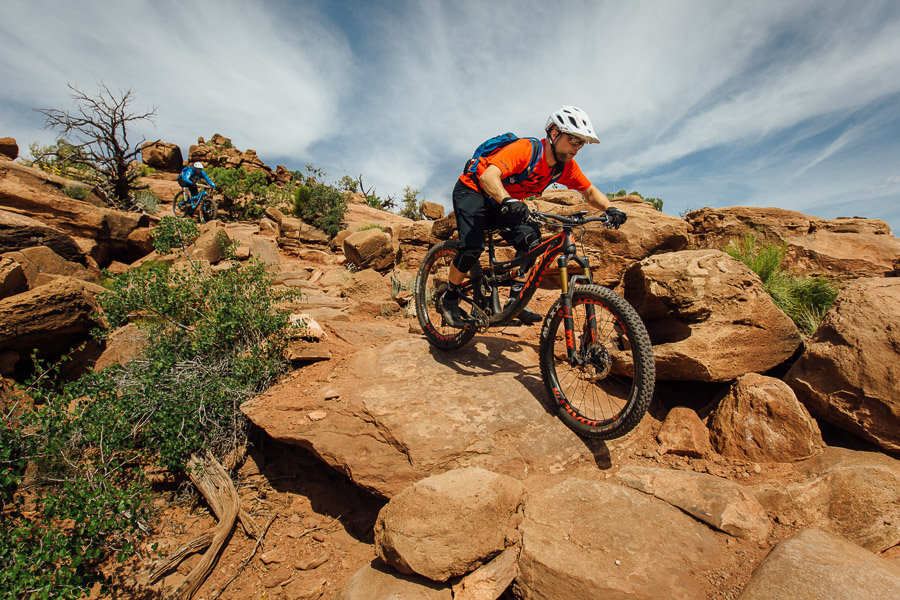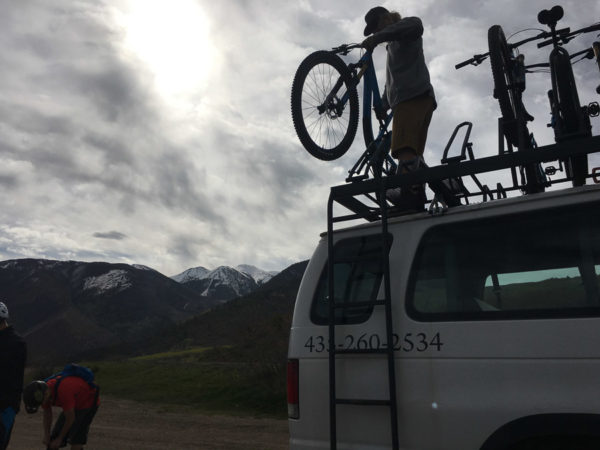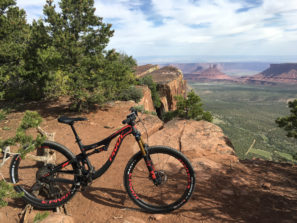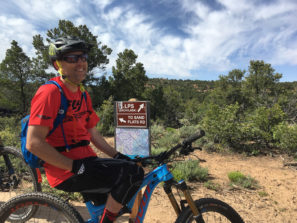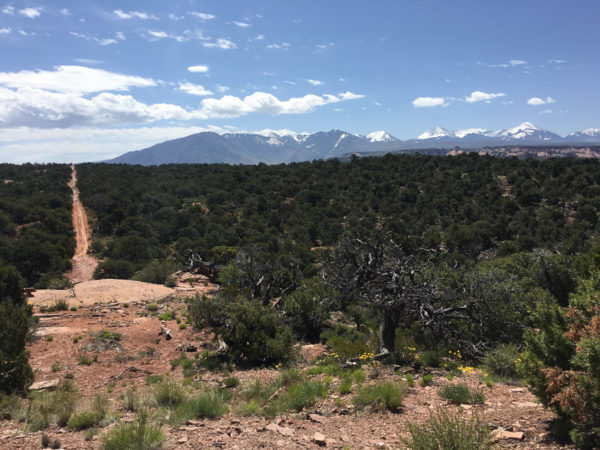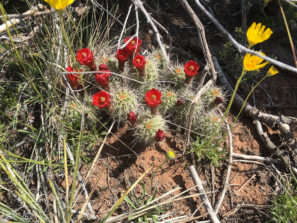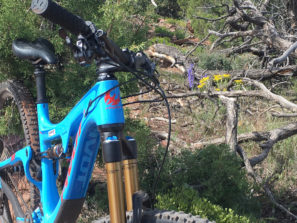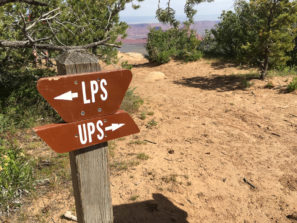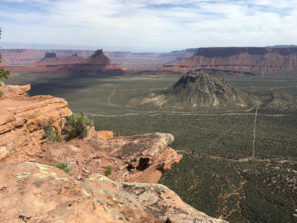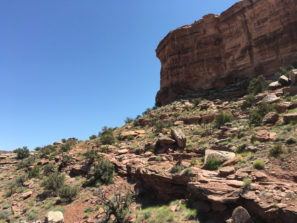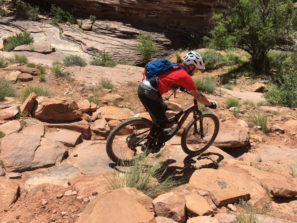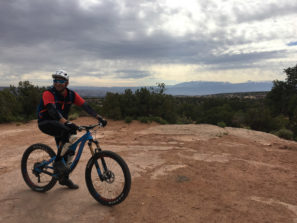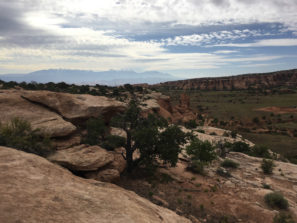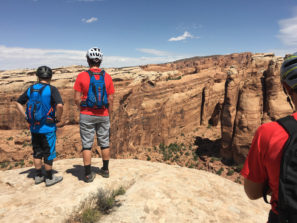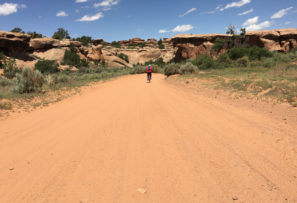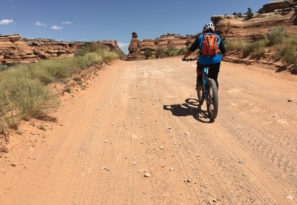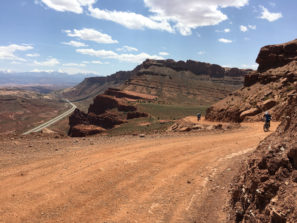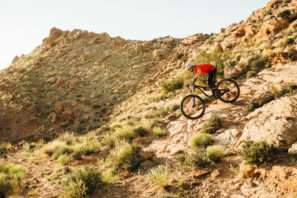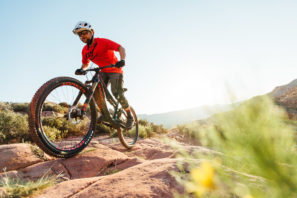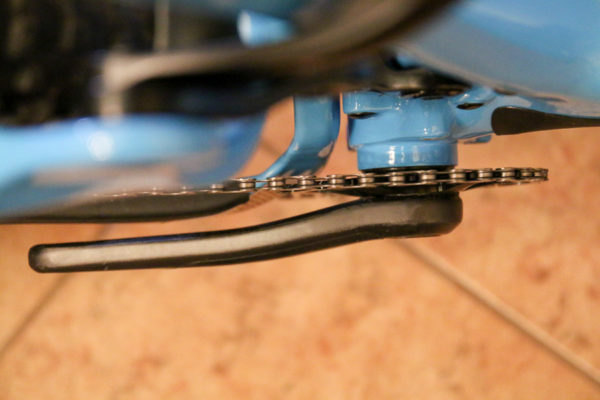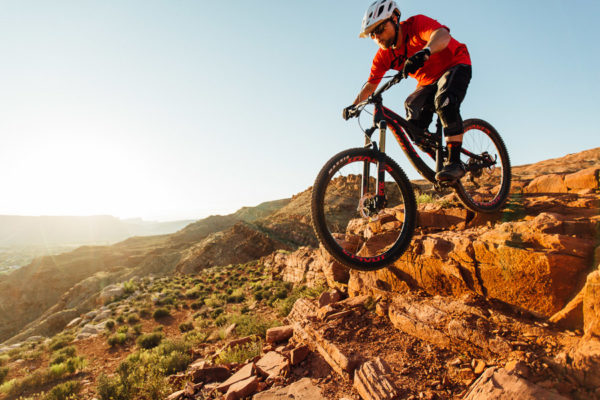
For the launch of their newest bike, Pivot did things a bit differently. After showing up to Moab, the only information we were given on the Switchblade was that which we could detect with our own eyes. The bikes were set up to our exact specifications, pressures dialed, and pedals installed. Soon it was time for dinner so we could be up bright and early to hit the trail.
As we boarded the Whole Enchilada shuttle, we knew that the bikes we were about to ride were capable of running 27.5+ or 29″ wheels, and that they were longer travel than anything we’ve seen from Pivot with the big wheels. We also knew we were in for the quintessential Moab experience as we climbed to the highest spot currently open on the famous Porcupine Rim Trail.
It was no secret that our first ride on the Switchblade would be on 29″ wheels. We just didn’t know just how much fun the next few hours would be…
Ask anyone who has ridden it, and they can attest to the chunder fest that is Porcupine Rim. Depending on where you start, the trail offers miles and miles of mostly downhill riding but with copious amounts of square edged rocks that all seem like they’re pointing the wrong way. It’s one of those trails that, ridden with some finesse, can be one of the most enjoyable experiences you can have on a mountain bike. But ride too aggressively or heavy handed and you’ll find yourself sitting trail side fixing flat tires more than actually riding.
After a sketchy, fast warm up on the Kokopelli Trail, it wasn’t long until the Switchblade started coming into its own. I’ve ridden Porcupine a few times now, but on a 29er this was a first. Based on the performance of the Switchblade it probably won’t be the last either. Just like the trail, the Switchblade seemed to ride better the faster you went. Chunky, sharp rock gardens were flattened by the bike’s 150/135mm travel while the 29 x 2.3″ Maxxis High Roller IIs seemed completely up for the challenge. We didn’t know it at the time, but our streak of zero flats would continue for all three days – a testament to the Maxxis tire construction and DT Swiss and Reynolds rim profiles.
To me, the best attribute of the Switchblade was instantly apparent after the first drop. For a longer travel bike with 29″ wheels, this thing manuals and pulls up incredibly well. That’s not really surprising when you consider the 16.85″ chain stays, but it translates extremely well to the trail.
All too soon, we were down to the Colorado river with only one small mechanical thanks to an errant rock and an unfortunate rear derailleur. My first impression of the Switchblade was very, very positive. You really couldn’t expect a better experience on Porcupine rim. The weather was perfect with average temps in the low 70’s. The trails were rolling fast thanks to recent rain. Traffic was limited, and everyone was laughing and smiling all the way down the 17 mile ripper. All I wanted to do was get back in the shuttle and do it again.
Instead we went back to base camp and got our first presentation on the bike. We listened to Pivot’s founder Chris Cocalis tell us about all of the geometry, suspension details, and ability to switch wheels, but they saved the best for last. After the presentation we were ready to test out the bike with 27 x 2.8″ Maxxis Rekon tires and Reynolds carbon rims, but we still didn’t have the full story.
The following morning we piled on the sunscreen, stuffed ourselves full of food and headed out to the start of Mag 7 near Deadhorse Point. From here it’s a rolling slick rock pump track of a trail that heads towards town. With more pedaling and less high speed descending than Porcupine, it was an interesting introduction to the Switchblade with 27.5″ wheels. A few things stuck out right away – plus tires are awesome for the sandy slick rock zones you’ll find in Moab, and the Switchblade is indeed two bikes in one.
After starting all the bikes at the same 17.5 psi ft/20.5 psi rr pressures, it didn’t take long for me to realize I wasn’t experiencing the same traction stoke as many of the other riders. As one of the smaller riders in the group, I decided to let out a bit of pressure from both tires. This made a huge difference. After the ride, Chris ended up measuring the pressures in my tires which ended up at 16 psi ft/19 psi rr, which turns out to be the same pressures he runs back home in Phoenix. The threat of puncturing on Moab’s many square edges inspired Pivot to add a little extra air to each tire, but in the end I managed not to flat even with the lower pressures.
Following some killer views, pump track like sections of slick rock, and miles of Utah desert, we reached the rim on Gold Bar and were rewarded with incredible views of the valley below and Moab beyond. From this point we had a choice, continue on Blue Dot to exit the trail through Portal, or turn around and climb Gemini Bridges road to exit to Bar M. Our crew ended up splitting into two, but both groups ended up with over 20 miles of riding on the day and another great experience on the Switchblade.
It was here on this ride out of the canyon that the Plus tires really shined. Deep sand beckoned, just waiting for you to spin a tire and lose all forward momentum. For a section that Chris said can be nearly unrideable on standard mountain bikes, the Plus tires provided noticeable flotation and kept us chugging forward.
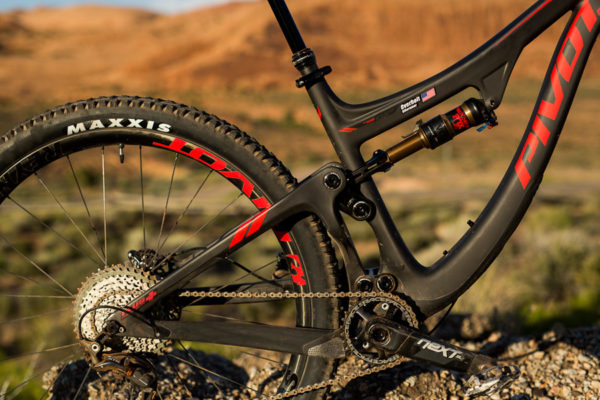
Immediately following lunch and the shuttle back to base, we were in for the final presentation. Even though it was kept secret, a few of us had some idea what we were in for. This was the unveiling of Super Boost +. If you haven’t read our tech breakdown of the new bike, you should definitely do so. In it you’ll learn that Super Boost + isn’t really a new standard at all. Instead, Pivot made use of an existing hub width from DH bikes with the 157 x 12mm rear hubs. The only difference is that Pivot worked with Industry 9 and Reynolds to create a custom hub that uses the exact same axle spacing, but has wider spoke flanges for a stiffer wheel build. Up front the bike uses stock cranks and bottom brackets with one exception on the RaceFace Next SL G4 crank which needs a Plus Spindle. Pivot views Super Boost + as the hub fitment that should have been adopted in the first place rather than Boost 148, but accepts the fact that Super Boost + won’t be a great option for XC or Trail bikes. The result is a bike with super short chain stays, massive tire clearance, increased stiffness, and a frame that can still run a front derailleur with better chainline for 1x drivetrains as well.
Rather than cloud our judgement by telling us about it up front, Pivot wanted to see if we noticed anything off about the performance of the bike first. Pivot claims the Switchblade has better heel clearance and the same Q-factor as their Mach 4, and I believe them. You would never be able to tell just from riding the bike that is has a 157mm rear hub – except maybe the fact that it is impressively stiff for a 135mm travel 29er/27.5+.
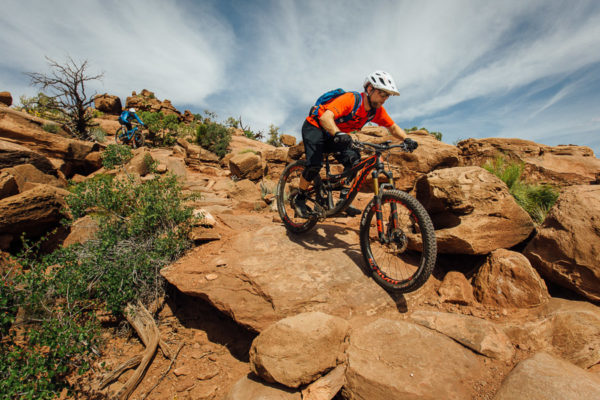
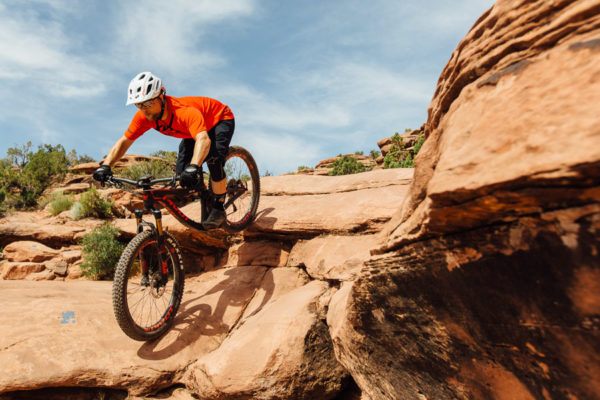
On our third and final trail day, we headed out to ride Hymasa and Captain Ahab. Another iconic Moab trail, I’ll admit I was a little bummed to not be able to ride it last time I was in Moab since it’s closed to e-bikes. This time, there was no holding back. Since all of us had been on the Switchblade in both 29 and 27.5+, for this ride we were given the choice of wheel size for the day. Depending on the rider, choices varied, with myself opting to stick with the 27.5+ given the fact that there would be a lot of off camber slick rock climbing. In the end, I think I made the right decision. The bigger tires helped iron out the irregularities in the slick rock, and helped hide some rider error due to the fatigue of a big week of riding both Sedona and Moab. Regardless, we made our way to the top of the climb and were rewarded with a super fun, technical blast down to the bottom.
Photos c. Pivot Cycles/Lear Miller
Wanting to get a bit more time on the bike with 29″ wheels and take advantage of Lear Miller’s incredible skills behind the lens, we headed out one last time to do some shooting on Dave’s trail. The short trail is the more fun, but way more difficult route home from the top of Slick Rock Trail. In this case I left the 17mm lower headset cup in place to get a feeling of the bike slacked out a bit. Due to the smaller overall diameter of the 27.5+ wheels and tires, the 17mm headset cup raises the bottom bracket and keeps the angles to within 1/2º. With the 29″ wheels, the spacer makes the front end about 7mm taller than a 160mm fork, but Pivot says it’s an acceptable way to ride the bike.
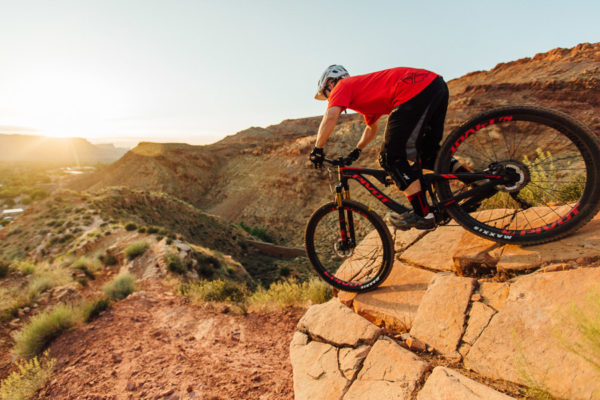
After rolling down Dave’s trail a ways, the additional slack was welcomed as I was treated to a very techy trail that was completely new to me. After clearing a number of challenging sections, the biggest difference between the 29″ and the 27.5+ wheels began to emerge. To me, the 29ers were the scalpels while the Plus wheels were more of a hammer. With the right touch, the 29ers provided more precision to send tough lines and rebounded less which made a series of sketchy moves a bit easier. However, when it comes to pounding through slick rock sections, or sort of bumbling through your line, the Plus tires are very forgiving.
Initially, when we were told that we’d be riding 29ers down Porcupine rim, I felt a little disappointed that we wouldn’t be able to ride it on Plus. Looking back though, it was definitely the right call. Running much higher pressures (26 psi ft/32 psi rr) meant that we were able to blast through the whole trail oblivious to flats, and the added precision of the narrower tires surely helped on a number of difficult moves. The Switchblade continues to add to the validity of Plus tires for many riders, but perhaps more so, the bike really highlighted the abilities of 29″ wheels on the right chassis and on the right trail.
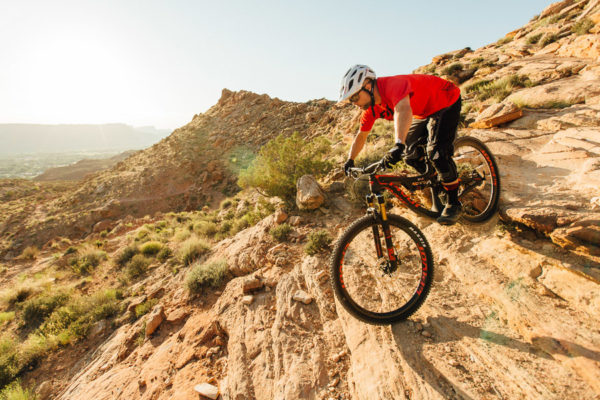
If you haven’t picked up on it by now, the Switchblade is an incredible machine. I don’t think it’s a stretch to say this is the best Pivot to date. It may even qualify as the best 29er I’ve ridden thanks to the bike’s willingness to manual, wheelie, and pop as a result of the short chain stays. Like most bikes though, the Switchblade is about more than geometry. The DW Link suspension provides a platform that doesn’t squat under power allowing for a lower BB height (though I still definitely needed the RaceFace crank boots), and the Fox 36 and Float DPS EVOL suspension is a welcome addition to such a capable bike.
More importantly for me, Pivot’s new Long and Low geometry is a perfect fit. I have always known I have a bit of an odd fit on a bike, so the ability to get the reach I’m looking for in the top tube while still maintaining the ability to run a 150mm dropper post is huge.
Regarding the Super Boost +, it’s not something we’ve seen before on an Enduro bike, but it seems like a logical step. Pivot has proven that the use of the 157 x 12mm rear hub doesn’t require changes to the Q-Factor or heel clearance, and the benefits are undeniable. The only thing I could say about the wider chainline of the bike is that it seemed that I noticed the chain tapping the inside of my ankle more when really pushing the bike through the rough stuff while coasting. It wasn’t bothersome, just something I picked up on.
If you ride right-foot-forward this likely wouldn’t even register as an issue. It’s also possible that we were riding terrain that was so rough at speeds that any bike would bounce the chain around. Then there is also the fact that if this was a real issue (not just an observation), you could add a chain guide with a lower roller which should keep the chain more in check.
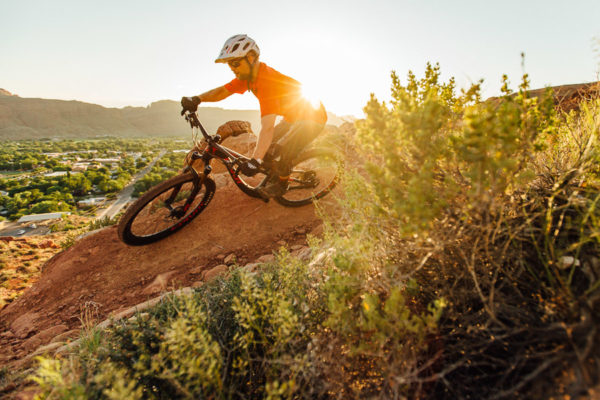
When you add it all together – the long and low geometry, frame clearance for bigger dropper posts, the ability to run almost any drivetrain, effective bottle cage mounts, and a super stiff frame that pedals extremely well while maintaining the ability to run two completely different wheel sets, the Switchblade is exactly the bike Pivot needed to add to their line up.
And it’s one I was very sad to leave behind in Moab.
